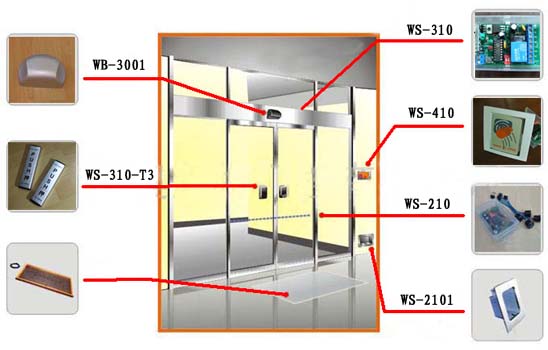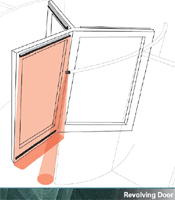 |
|
|
Sensor Application:
------------------------------------------------------------------------------Sensing the Future in Automatic Door SensorsToday, there are mainly three different sensor technologies used in the market. Active Infrared
Active Infrared Detectors are static—they only detect persons and objects if they break the beam. The detection area consists of spots, and depends to a large extent, on the optical center-to- center distances of the transmitter and receiver lenses. Several beams can be combined in a modular system to form a larger area. Choose from: Background suppression presence detectors are used on moving parts like a swing door or revolving door. This system does not require a background like a wall or floor. Background analysis requires a signal from the background in order to switch the output.
Passive Infrared Functional Principles: Passive Infrared Sensors function in a similar way to infrared cameras used to detect heat loss from buildings. The infrared-sensitive sensor forms a heat image of the defined area to be monitored. After an initial set-up time of approximately 20 seconds, the measured infrared image is saved. The sensor switches if the heat image changes as a result of movement. Two conditions must be fulfilled here: 1. There must be a temperature difference of +/- 1.8 F between the object to be detected and the background.
Microwave Functional Principles: Microwaves are electromagnetic waves such as those emitted by a radio transmitter but with a much higher frequency (> 1GHz). Thanks to the variable antenna, the microwaves emitted by the transmitter can be directed without any difficulty and are reflected back to the receiver via the floor, walls and other surfaces. If there is no movement in the monitored zone, the transmitter and receiver frequency remain the same—the zone is clear. People and objects, however, activate the motion detector as they move through the monitored zone. The emitted and received frequencies are no longer identical. The difference between the frequencies is evaluated and transferred via relay or electronic contacts in the form of a switching pulse. The microwave power used is perfectly safe for humans and animals. How to Combat Interference In addition to known influencing factors such as rain, snow, fluorescent lamps and fundamental vibrations of door drives, there has also been a steady increase in parasitic interference caused by items such as mobile phones, radio and X-ray equipment—commonly called electrosmog. Optimized circuits and other suppression components provide extensive protection. Today, more special features are available. Environmental awareness, and energy and cost-savings are not just empty promises anymore. (See application pictures ). Here are some of the features available:
The most common doors are sliding, swing and revolving doors. There are low-cost sensors, which basically can only fulfill one major duty—detection or not. But there are also sophisticated sensors available which not only open a door, but can also be used for special applications. For example: a hotel entrance door that’s activated every time a car pulls up. This action can now be eliminated. Today, there are sensors that will ignore cross-traffic, only activating the doors when a person walks toward it. Many hotel managers will be glad to hear that. Active infrared sensors are not only being used to activate a door, but also to detect presence so a door doesn’t close while a person or object is still in the door’s path.? Swing doors are by far the most common automated pedestrian doors in North America. Most swing doors are activated by a sensor and secured by another. We differentiate between a header-mounted sensor and a door-mounted sensor. Header-mounted sensors are often used for activation, but there are also header-mounted sensors available for safety. Door-mounted sensors are basically for presence-detection to assure the door is not closing on a person in the path. Sliding doors are the second-most used doors in the industry. Generally, the swing door is activated on both sides, and also has some presence features, either by beams in the threshold or a presence sensor. There are also combined sensors available on the market where the activation and presence is included in one unit. Revolving doors are common, but seldom are they fully automated. A fully automated revolving door requires a set of activation and safety sensors. Activation sensors start the movement of the door; presence sensors assure no one is being hit by a moving door. Often, there is a single beam sensor on the closing edge, a presence detector on the moving leaf and, in addition, there are mostly electrical sensing edges and safety mats used. |
| © 2009 Shanghai Wafer Microelectronics Co.,Ltd - Manufacture Automatic door microwave Motion sensors ,Safety beam sensors and Swtiches. |
| ADD:23E,LiangFeng Building, No.8, DongFang Road,Shanghai,China |
| Tel:+86-21-51870528 | Fax:+86-21-50454820 |
| Email:wafer@waferstar.com Company Links: www.waferstar.com www.coinco.cn www.coin-payment.com www.wafersensor.com |

 Functional Principles: An Active Infrared Detector always consists of one transmitter and at least two receiver chips with high-quality optical systems. The scanning range is set by means of a mechanical micro-speed unit by changing the angle between the transmitter and receiver. This optical procedure is called triangulation or optical differential measurement.
Functional Principles: An Active Infrared Detector always consists of one transmitter and at least two receiver chips with high-quality optical systems. The scanning range is set by means of a mechanical micro-speed unit by changing the angle between the transmitter and receiver. This optical procedure is called triangulation or optical differential measurement. The system is ideal for detecting people only if— There is always a difference of at least 1.8 F between the surface temperature of a clothed person and the surrounding environment. For reasons of a physical nature, this technology should only be used to detect living beings as it’s not always possible to guarantee that the difference in temperature between items such as shopping carts or vehicles, and that of the surrounding environment will be great enough.
The system is ideal for detecting people only if— There is always a difference of at least 1.8 F between the surface temperature of a clothed person and the surrounding environment. For reasons of a physical nature, this technology should only be used to detect living beings as it’s not always possible to guarantee that the difference in temperature between items such as shopping carts or vehicles, and that of the surrounding environment will be great enough. Different Sensors for Different Applications
Different Sensors for Different Applications